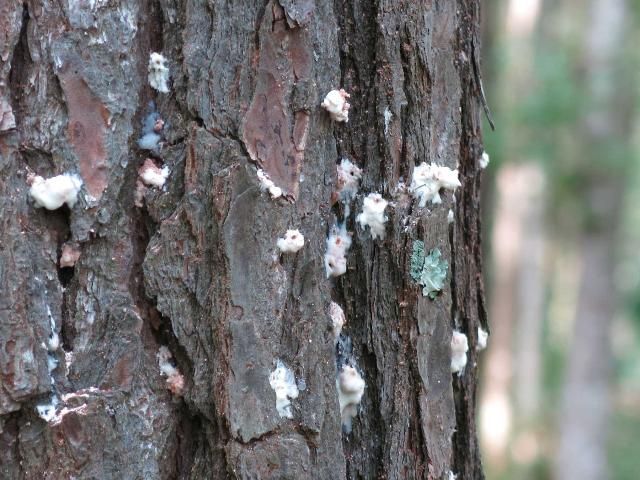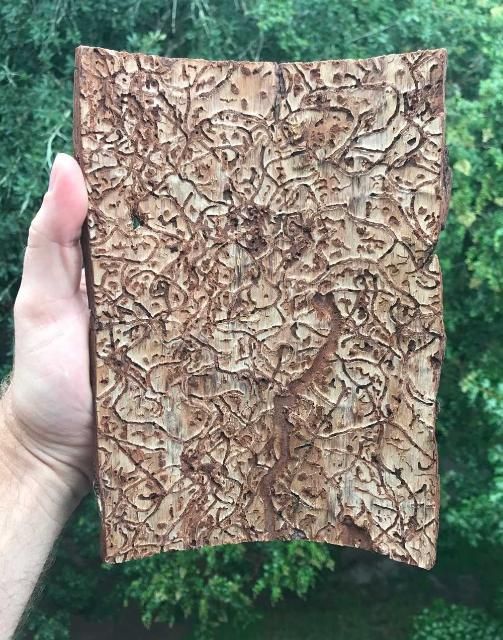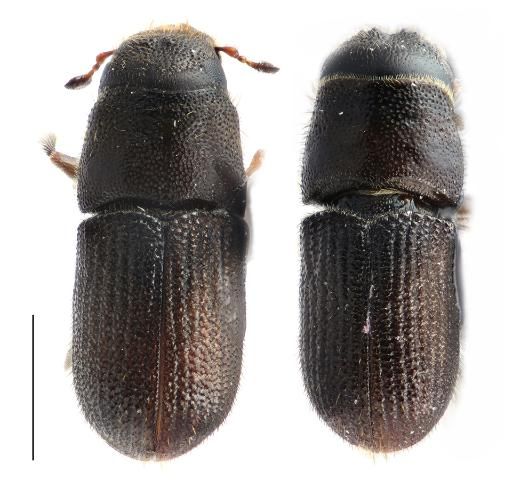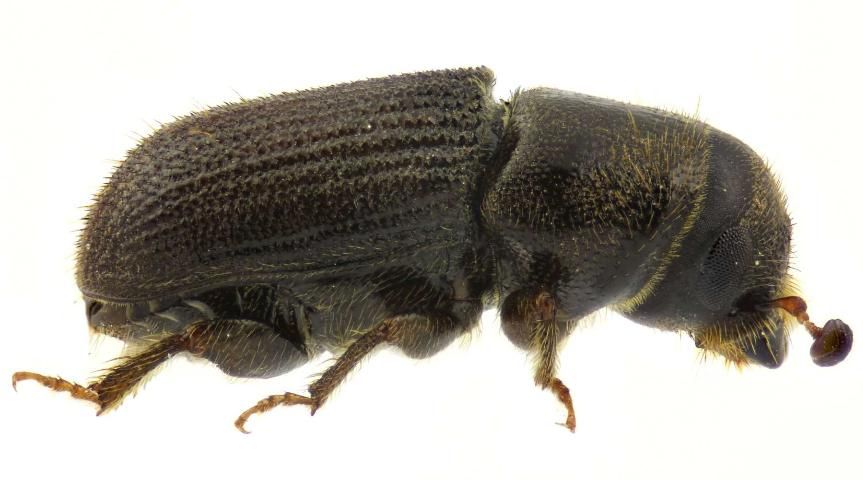The Southern Pine Beetle, Dendroctonus frontalis (Coleoptera: Curculionidae: Scolytinae)
The Featured Creatures collection provides in-depth profiles of insects, nematodes, arachnids and other organisms relevant to Florida. These profiles are intended for the use of interested laypersons with some knowledge of biology as well as academic audiences.
Introduction
The southern pine beetle (SPB), Dendroctonus frontalis Zimmermann, has been the most economically important forest insect in the pine timber industry in the southern United States. From 1960 through 1990, the bark beetle caused economic losses estimated at $900 million (Price et al. 1992). From 1998 to 2002, a four-year outbreak in the southern Appalachian Mountains affected more than 1 million acres with an economic loss of more than $1 billion (Clarke and Nowak 2009). In 2001, 17,599 acres of pine forest were damaged by SPB in Florida alone, causing an estimated $38 million in damage.
While the spectacular outbreaks have captured attention, equally interesting are the long periods of beetle absence between outbreaks, and the factors that maintain its low population. Recent observations suggest that in natural conditions the beetle is a rare insect and rarely responds with an outbreak unless silvicultural practices create a suitable environment: overstocked, even-aged, large pine stands. Despite many decades of research on the ecology of the beetle, we lack a complete understanding of its population dynamics, and its original (preindustrial) ecology remains elusive (Asaro et al. 2017). Fortunately, silvicultural practices leading to resistant stands are now commonplace and principally include thinning (either mechanical or by fire) and rapid detection and removal of infestations (Nowak et al. 2015).

Credit: Jiri Hulcr, UF/IFAS

Credit: Jiri Hulcr, UF/IFAS
Correcting SPB Myths
The southern pine beetle is a formidable pest, but also a species with a unique ecology and behavior, different from all other southern wood borers. This makes it a topic of many speculations. Below are some of the “myths” – frequent claims that are not supported by evidence – that are often repeated in research literature as well as in practical forestry. These topics are further developed in the text below.
- “SPB is a common pest." It is only common during outbreaks, which occur almost exclusively in and around areas with overstocked pine stands. Outside of these events, SPB is a rare beetle.
- “My tree maintenance guy tells me that my pine has beetles, so I have to remove it.” Every dead pine in the Southeast gets colonized by bark beetles and wood-boring beetles, but most of these are secondary species that do not attack nearby healthy trees. Unless your area is experiencing a major outbreak, pines attacked by SPB are rare! Correct identification of the insect is critical; the beetles found in most dead pines are not a threat to living trees.
- “Pitch tubes produced by SPB are white, pitch tubes made by secondary beetles are red.” The color of the resin depends on other factors; pitch tubes of SPB can be either white or red. For a proper diagnosis, the bark has to be peeled and the pattern of the beetle tunnels examined.
- “SPB prefers loblolly over other pine species.” Although SPB outbreaks are more common in loblolly pine stands, recent research has found that when an infestation occurs in a stand containing both loblolly and longleaf pines, the longleaf pines are equally likely to be attacked and killed (Martinson et al. 2007). While this question is not completely settled, ’it's possible that most outbreaks have developed in loblolly pine stands mainly because they used to be widespread and are often densely planted, while dense stands of other pine species are less common.
- “My pine has bark beetles, I need to control them with insecticide.” Once SPB has successfully colonized a tree, the tree cannot survive, regardless of control measures. The currently available insecticides can only be used as prevention before beetle attack (Grosman et al. 2009).
- “SPB kills the tree using a fungal pathogen.” The southern pine beetle feeds on a symbiotic fungus introduced into the phloem. This fungus is not a tree pathogen. Besides the nutritional fungus, SPB sometimes carries other fungi, including the so-called “blue stain” fungi. Older scientific literature suggested that some of these secondary fungi may be helpful or necessary for SPB to kill a tree. Contemporary evidence does not support this claim; in fact, the blue stain fungi are harmful to the beetle larvae. What kills the tree is the beetle mass attack.
Distribution
Southern pine beetle has historically occurred in a generally continuous distribution across the southern, southeastern, and northeastern United States (AL, AR, FL, GA, KY, LA, MS, MO, NC, OK, SC, TN, TX, VA, and WV). Southern pine beetle also occurs in discontinuous fashion from AZ and NM south through Mexico and Central America into northern Nicaragua (Billings and Schmidtke 2002). The beetle is common in north Florida, but its abundance decreases southwards, and there is no known record of an SPB outbreak south of Osceola County. Southern pine beetle is unlikely to occur south of N 28° 15' latitude in Florida. The most likely hypothesis for this distribution is the scarcity and/or lack of loblolly pine in the southern half of the state. In the northeastern United States, SPB has recently (since 2014) expanded into Connecticut, New York, and Rhode Island, as a result of warmer winter temperatures (Lombardo et al. 2018).
Description
Eggs are 1.5 x 1.0 mm, oval in shape, shiny, opaque, and pearly white. Larvae range in size from 2 to 7 mm in length and are wrinkled, legless, and yellowish-white, with reddish-colored heads (Meeker et al. 2000). Pupae are the same general color as larvae and the same general form and size of adults. Adults are 2 to 4 mm long, short-legged, cylindrical, and brown to black. In males, the head has a distinct notch or frontal groove. Females possess a broad, elevated, transverse ridge along the anterior pronotum, which conceals the mycangium. The rear end or abdomen of adults is rounded, as opposed to some other pine bark beetles (such as Ips) in which the abdomen is impressed, or hollowed out, and surrounded with teeth. Callow (new) adults progressively change in color from yellow to dark brown (Hain et al. 2011).

Credit: Demian Gomez, UF/IFAS

Credit: Jiri Hulcr, UF/IFAS
Diagnosis
The genus Dendroctonus can be distinguished from most other pine bark beetle genera by the head, which in this species is easily visible from above. In most other pine bark beetle groups, the head is hidden underneath the thorax when the beetle is viewed from above. Within the genus Dendroctonus, there is only one other species in the Southeast—the black turpentine beetle D. terebrans—and that is comparatively huge, more than twice as large. Several species in the genera Hylurgops and Hylastes are also superficially similar, but they never attack healthy pines. For more information about bark beetle identification, we recommend Bateman and Hulcr (2017).
Attacks by SPB are easily distinguished from other pine bark beetle attacks by several features. First, pitch tubes are almost always in crevices, rather than on bark plates. Pitch tubes are spread out along the main stem of the tree and less common at the base or in the crown. The color and consistency of pitch tubes are not diagnostic. The galleries of SPB are distinctive in their zig-zag to “s” shape, and the very short larval tunnels ending in feeding chambers.
Biology
Tree Colonization
The southern pine beetle is a native insect that develops in the phloem and the inner bark of pine trees. In natural conditions, attacks are generally restricted to damaged pines, typically trees injured by fire or lightning strike. Interestingly, chronically stressed pines do not seem to support SPB populations – drought stressed or shaded-out pines are rarely colonized.
Adult SPB female is the primary colonizing sex that selects the host tree (Hain et al. 2011). After locating a suitable host tree, a female beetle bores through the bark to initiate gallery construction in the inner phloem. Soon after initial attack, females emit an aggregation pheromone (frontalin), which, in conjunction with host odors stemming from resin exudation at attack points, attracts other southern pine beetles, both males and females, to the tree. Males then release endo-brevicomin, which synergizes the attraction of frontalin at low concentrations (Sullivan 2011). The aggregation of beetles results in a mass attack over a short period of time (Dixon and Payne 1979). Mass-attacking enables SPB to overcome the natural defense mechanisms of the tree, especially constitutive resin production. This resin under pressure can successfully “pitch out” beetles if there are only a few attacking beetles and the tree is relatively healthy. Mass-attacking SPB deplete the resin production of the tree and cause resin flow to cease, after which point the tree is easily overcome.
Trees attacked by southern pine beetle often exhibit hundreds of resin masses (i.e., pitch tubes) that appear as “popcorn” on the outer tree bark. Southern pine beetle females colonize live or freshly dead phloem tissue, where they construct winding, S-shaped or serpentine galleries. The galleries can effectively girdle a tree, causing its death (Hain et al. 2011).
Association with Fungi
Instead of feeding on the tree tissue like most bark beetles, the southern pine beetle progeny feeds and develops on a symbiotic fungus Entomocorticium (E. perryae in Florida and E. cobbii in Louisiana; Araújo et al. 2021, Harrington et al. 2021). This fungus is introduced into the phloem by the female and serves as the predominant source of nutrition for the larvae. Hence, the larval tunnels of Dendroctonus frontalis are very short, mostly consisting of a chamber with symbiotic fungi on the walls; this is in contrast with most other bark beetles that colonize southern pines, whose larvae burrow long tunnels through the phloem. To transport the fungus to new trees, southern pine beetle females possess mycangia, specialized structures in which they carry their symbiotic fungus.
The southern pine beetle also inadvertently mediates the transmission of blue-stain fungi such as Ophiostoma minus. The role of these fungi in the tree death is not completely settled, but the majority of evidence supports the scenario that these are associated with phoretic mites (Hofstetter et al., 2006a), that they compete with the Dendroctonus larvae (Barras 1970), and that they have very little impact on the tree death compared with the actual beetle attack (Six and Wingfield 2011).
Occasionally Ceratocystiopsis ranaculosus also occupies the mycangium but its relationship with the beetle is not clear.
Population Dynamics
Populations of the southern pine beetle can grow quickly, however, in the suitable environment: overstocked (high-density) or overmature pine stands. In these settings, SPB can enter into an aggressively spreading epidemic phase. These epidemics often originate in injured trees, typically after a lightning strike, and the growing beetle population begins to invade and overcome nearby healthy, vigorous trees via mass attacks over a period of a few weeks (Coulson and Klepzig 2011). Widespread and severe tree mortality can occur during epidemics as spots (groups of infested trees) may expand at rates up to 15 m (50 ft.)/day. Infestations in suitable pine stands may grow to cover thousands of acres and persist for multiple beetle generations, continuing to spread until the hosts run out, or until halted by extreme temperatures, direct control, or other factors (Billings 2011). While SPB cause the greatest impact in conventional pine plantations, non-managed forests are also at risk. This is often observed in public conservation lands where the pines have reached advanced age. If the local SPB population is in an outbreak status in the area it may also kill isolated trees in yards, parks, and ornamental settings (Coulson and Klepzig 2011).
In the South, tree stressors including changes in climate and precipitation regimes induce numerous cases of tree mortality. While nearly all such dying or dead pines display signs of colonization by various bark beetles, most of these involve secondary species that will not attack healthy trees. Typically, only SPB infestations pose the risk of an epidemic. Therefore, to make informed management decisions, care should be taken not to confuse SPB with less aggressive but more common pine bark beetles of Florida, such as pine engravers (three Ips species) and black turpentine beetle (Dendroctonus terebrans) (Hulcr 2019).
Life Cycle
After the male is accepted into the female’s gallery, mating soon takes place and females begin to construct long, winding, S-shaped galleries that cross over each other. These galleries are packed with frass and boring material. Parent adults may then reemerge from the tree one to 20 days after oviposition and proceed to attack the same tree or another (Hain et al. 2011). Eggs hatch 3 to 34 days after oviposition depending on temperature (Hain et al. 2011). Larvae construct very short galleries (usually less than two centimeters) in the phloem perpendicular to parent egg galleries. Each tunnel ends in a chamber where the larva develops and consumes, almost exclusively, the symbiotic fungus. As chambers are expanded towards the outer bark, the last instar larvae move to the outer bark and form pupal cells. The pupal stage lasts 15 to 40 days, during which time the insects turn into callow adults. Callow adults remain under the bark for six to 14 days while their cuticle hardens and darkens. The young adults then bore an exit tunnel directly through the outer bark, leaving an exit hole behind. Generally, the emerging beetles fly off to seek another tree. Flight is the most dangerous part of the beetle’s life, and their interest is to find a suitable tree as soon as possible, ideally the neighboring tree. But in the absence of suitable trees, the adult beetles are capable of flying up to 2 miles (3 km) and it is estimated that during dispersal phases half of the beetles travel more than 0.43 mile (0.69 km) (Turchin and Thoeny 1993). The duration from egg to adult ranges from 26 to 54 days (Hain et al. 2011). There may be as many as seven generations per year in Florida.
In the South, emergence of overwintering beetles used to be previously correlated with the blossoming of flowering dogwood (Cornus florida L.) or redbud (Cercis canadensis) in the spring (Coulson and Klepzig 2011). However, as winter temperatures continue to rise, the plant phenology is unreliable, the beetles fly increasingly year-round, and this correlation is no longer reliable (J. Eickwort, Florida Forest Service, pers. comm.). Spring emergence of SPB represents the primary dispersal phase, during which beetles often initiate infestations. During summer months, beetle development is hastened, and infestations tend to proliferate and expand rapidly. In the fall, southern pine beetle tends to produce scattered small infestations. These infestations typically remain small and dispersed during the winter months when beetle activity is slowest (Hain et al. 2011).
Population Control by Natural Enemies
The Southern pine beetle is attacked by large numbers of natural enemies, ranging from pathogenic fungi to insect predators and parasitoids. The predators, for example, have evolved to detect the pheromones of SPB and lay eggs on attacked pines, while the hatched predator’s larvae search for the SPB larvae under the bark. The influence of predators on the SPB population is so strong that the state and federal SPB prediction surveys use the relative abundance of predators (specifically, the clerid beetle Thanasimus dubius) as a predictor of SPB population development. There is evidence that a persistent insecticide application suppresses natural enemies more than the pest, which can then multiply into a chronically high population (Williamson and Vité 1971).
The community of predators, parasites and pathogens of the southern pine beetle frequently causes such high mortality of SPB within the attacked tree that very few new beetles emerge. That is why the community is sometimes termed the “biological buffer." Unfortunately, there is almost no current research on the biological buffer. We do not know what conditions lead to the suppression of SPB by the natural enemies and current silviculture does not use them as a part of the pest management toolkit.
Hosts
Southern pine beetle can infest and kill any species of pine within its distribution (Birt 2011), but outbreaks are most commonly observed in loblolly pine stands. It is not clear if this is a result of preference for this host or of the widespread availability of high-density stands of this host. In addition to loblolly, the other common hosts in the SE USA are shortleaf pine (Pinus echinata Mill.), pond pine (Pinus serotina Michx.), and Virginia pine (Pinus virginiana Mill.) (Coulson and Klepzig 2011). In Florida, SPB also attacks and kills spruce pine (Pinus glabra Walter) and sand pine (Pinus clausa (Chapman ex Engelm.) Vasey ex Sarg.) (Chellman and Wilkinson 1975). Slash pine (Pinus elliottii Engelm.) and longleaf pine (Pinus palustris Mill.) are considered to be more resistant to southern pine beetle attacks, but during outbreaks even healthy individuals of these species can be successfully colonized (Belanger et al. 1993; Belanger and Malac 1980). Moreover, it has been recently shown that P. palustris and P. taeda are equally attacked and killed when they co-occur in a growing infestation (Martison et al. 2007). In the northeastern United States, SPB mainly attacks pitch pine (Pinus rigida Mill.), shortleaf pine (Pinus echinata), and Virginia pine (Pinus virginiana) and it has also been observed infesting Norway spruce (Picea abies L.), red pine (Pinus resinosa Sol. ex Aiton), scots pine (Pinus sylvestris L.), and white pine (Pinus strobus L.) (Dodds et al. 2018).
Outbreaks
Outbreaks of SPB have traditionally been described as “cyclical”, but in reality, their occurrence is driven by host availability and previous population levels (Costanza et al. 2012). SPB outbreaks occur where pine trees are densely packed and of suitable age and last until such stand is depleted or until external forces prevent further population growth. These forces include management, weather, and possibly natural enemies (Meeker et al. 2000). Statements about outbreak “cycles” and their duration are common in literature but appear to have been invoked from peaks of disparate populations; varied monitoring resolution at different decades prevents robust analysis (Belanger et al. 1993; Price et al. 1992). Since the turn of the 21st century, SPB has shown a dramatic decline in outbreak activity over much of the South as compared to previous decades (Asaro et al. 2017). The last regionwide outbreak in the Southeast (1999–2002) impacted several pine species growing in unmanaged plantations or in mixed overmature pine & hardwood stands (Nowak et al. 2016). The recent outbreaks in National Forests occurred in high-risk stands and very little of the population has spread beyond the national forest boundaries (Asaro et al. 2017).
Historically, Florida has not experienced many destructive SPB episodes (Chellman and Wilkinson 1975, 1980), probably because of the relative lack of overstocked and contiguous areas of loblolly and shortleaf pine of susceptible ages. An outbreak in and around Alachua County during 1994 spurred a reconsideration of the threat SPB poses to Florida's pine forests, and this was followed by a larger outbreak across North Florida from 2000 to 2002. But since then, low activity of the southern pine beetle has been registered. Only a localized resurgence occurred in 2016 through 2018, with little to no activity detected in the following years.
Currently the most significant activity of the southern pine beetle is occurring in the northeastern United States. The unprecedented expansion of SPB into New Jersey, New York, Connecticut and even Maine since 2014 has been attributed to warmer winters, which no longer limit the survival of larvae during hibernation, and to the pine stand conditions (mature and overstocked) (Dodds et al. 2018). Temperature change models show that climate will be increasingly suitable for SPB expansion into previously unaffected forests throughout the northeastern United States and into southeastern Canada (Lesk et al. 2017). Because of short generation times, dispersal abilities, and host distribution, changes in minimum annual temperatures have almost immediate effects on regional patterns of SPB infestations (Ungerer et al. 1999).
Damage Diagnosis
Often the first noticed indication of SPB attack is foliage discoloration. Crowns of dying pines change color from green to yellow to red before turning brown and falling from the tree (Meeker et al. 2000). However, especially in Florida, by the time crowns are red, SPB have already vacated the tree. The earliest sign of possible SPB attack is the presence of reddish-brown dust (from tunneling through outer bark layers), often combined with white pitch specks. A more noticeable indication of SPB attack is the appearance of numerous popcorn-size lumps of pitch (i.e., the pitch tubes) on the outer bark of pine stems (Meeker et al. 2000). These pitch tubes may occur from near ground level up to 20 m (60 ft) high but may not develop at all on trees severely weakened before beetle attack. The most diagnostic sign of SPB activity is the presence of the winding S-shaped galleries that cross over each other and are packed with boring dust and frass. These can be found by exposing a portion of the inner bark beneath pitch tubes or by removing a section of the bark. A sign of possible advanced SPB presence are the exit holes (1 mm in diameter) on the exterior bark surfaces where second-generation beetles have emerged (Billings and Pase 1979).
Monitoring
Southern pine beetle infestations typically kill groups of trees, the so-called “spots.” These spots of tree mortality result in a distinctive visual signature that allows for effective SPB monitoring. In Florida, the Florida Forest Service conducts an aerial survey program each summer in which spots are identified from aircraft and ground-truthed by local personnel. Forest landowners and land managers in and near the affected areas are immediately notified of any confirmed infestations, so that suppression efforts can be started as early as possible.
Southern pine beetle monitoring also takes advantage of the beetles’ chemical communication. Natural SPB attack is mediated by several semiochemicals involving pheromones released by females (frontalin), kairomones produced by the host (α-pinene and many others), and male pheromones ((+)-endo-brevicomin) (Sullivan et al. 2007). For monitoring purposes, frontalin and α-pinene are deployed in intercept (funnel) traps while (+)-endo-brevicomin is placed several meters away from the trap. Displacement of the release point of the male pheromone (4–16 m away) significantly enhances its synergistic effect on SPB attraction to traps with frontalin (Sullivan and Mori 2009). Traps using this combination of lures are deployed each spring by state forestry agencies in Florida and other southeastern states to identify areas that may be at elevated risk for southern pine beetle epidemics in the coming year, using a predictive model that takes into account the number of SPB as well as the number of predatory checkered beetles (Thanasimus dubius) collected in traps (Billings and Upton, 2010, Aoki 2017).
Prevention
Preventative strategies for homeowners and forest managers include:
- Plant less susceptible species such as longleaf pine and slash pine in place of loblolly pine, in the appropriate density. Plant loblolly pine only on appropriate sites (”the right tree for the right place”).
- Thin overstocked, dense, or stagnant stands to a basal area of 80 sq. ft. per ac. (18 sq. m per ha) or less and use prescribed fire to promote more open stand conditions.
- Maintain at least 25 ft. (8 m) distance between mature pines in urban settings.
- Promote tree diversity in the landscape.
- Remove severely damaged pines rapidly (such as those damaged by lightning, landscaping activities, etc.). While doing so, avoid damage to surrounding pines by heavy machinery as much as possible.
- Retain dead and dying trees from which SPB have already left. This strategy promotes the emergence of natural enemies, which are critical in the natural regulation of the pest population (the “biological buffer”). Trees that have already been abandoned by SPB can be recognized by distinctly red or grey needles, by numerous exit holes on bark flakes, and by the absence of the SPB larvae inside the bark (the latter can be difficult to see for an untrained observer).
- Minimize construction and logging damage to pines and avoid soil compaction during operations.
- Minimize changes in soil and water levels around pines.
- Conduct logging or land clearing operations during coolest winter months.
- Shorten rotation ages to less than 30 years.
- In terms of preventative insecticides, emamectin benzoate prophylactic injection is effective against SPB and approved for use in forests. Surface sprays bifenthrin or permethrin are approved only for ornamental settings, limiting their use to high-value trees when the threat of southern pine beetle attack is imminent, and the potential benefits outweigh the costs of chemical use and the damage to natural enemies. Carbaryl is approved for forests, but the chemical is not effective against the SPB (Berisford et al. 1981).
- For high value individual trees, consider systemic injection of systemic pesticides, such as emamectin benzoate (Grosman et al. 2009).
In Florida, the Florida Forest Service offers the Southern Pine Beetle Assistance and Prevention Program, with the goal to minimize regional outbreaks by helping landowners with proactive management practices (Nowak et al. 2008). The program, limited to 44 northern Florida counties located within the range of SPB, offers reimbursements or incentives for thinning, prescribed burning, mechanical underbrush control, and planting longleaf or slash pine. Circumstantial evidence suggests that a landscape-level preventative thinning is the most economical and sustainable approach to the mitigation of the southern pine beetle epidemics (Asaro et al. 2017).
Active Infestation Control
The current strategy for suppression relies on identifying the SPB spots and removing the “active” trees to prevent emergence of beetles and the loss of additional trees (Billings 2011).
“Cut-and-remove”: The most effective and desirable approach is to remove and process all southern pine beetle-infested pines as soon as possible (Billings 2011). Trees can be salvaged, and SPB will be destroyed in the milling process. It is recommended that a 50- to 100-ft. (15- to 30-m) buffer strip of green, uninfested trees also be removed ahead of the direction(s) where the spot is actively spreading, to ensure that recently infested trees are not left behind and to disrupt the pheromone-mediated spread into nearby un-infested trees.
“Cut-and-leave”: If trees cannot be salvaged or transported away from the pine forest, trees should be at least felled, which decreases larval survival (Swain and Remion 1981; Coulson and Klepzig 2011). To increase beetle mortality in the felled trees, bark can be peeled, or the entire tree can be chipped. Ideally, infested trees plus a buffer strip should be felled toward the center of the spot.
“Inactive trees”: Trees from which SPB already emerged should be left at the site. Such trees no longer pose danger, and they produce large numbers of natural enemies that can significantly decrease bark beetle population density (Turchin et al. 1999).
References
Aoki CF. 2017. Forest risk and irruptive insect pests: ecology for management in changing times. Dissertation. Dartmouth College, Hanover, NH USA. 143 pp.
Araújo JPM, Li Y, Six D, Rajchenberg M, Smith ME, Johnson AJ, Klepzig KD, Crous PW, Leal-Dutra CA, Skelton J, Adams SN, Hulcr J. 2021. Diversity and evolution of Entomocorticium (Russulales, Peniophoraceae), a genus of bark beetle mutualists derived from free-living, wood rotting Peniophora. Journal of Fungi 7(12): 1043-1069.
Asaro C, Nowak JT, Elledge A. 2017. Why have southern pine beetle outbreaks declined in the southeastern U.S. with the expansion of intensive pine silviculture? A brief review of hypotheses. Forest Ecology and Management 391: 338–348.
Barras SJ. 1970. Antagonism between Dendroctonus frontalis and the fungus Ceratocystis minor. Annals of the Entomological Society of America 63: 1187–1190.
Bateman C, Hulcr J. 2017. FOR321. A Guide to Florida’s Common Bark and Ambrosia Beetles. Gainesville: University of Florida Institute of Food and Agricultural Sciences. https://edis.ifas.ufl.edu/publication/FR389
Belanger RP, Hedden RL, Lorio Jr. PL. 1993. Management strategies to reduce losses from the southern pine beetle. Southern Journal of Applied Forestry 17: 150–154.
Belanger RP, Malac BF. 1980. Silviculture can reduce losses from the southern pine beetle. USDA Forest Service, Combined Forest Pest Research Development Program. Handbook No. 576. 17 p.
Berisford CW, Brady UE, Ragenovich IR. 1981. Residue studies, pp. 11-12. In F. L. Hastings and J. E. Coster [eds.], Field and laboratory evaluations of insecticides for southern pine beetle control. USDA For. Ser. Gen. Tech. Rep. SE-21.
Billings, RF 2011. Mechanical control of southern pine beetle infestations. In: Coulson RN, Klepzig KD. 2011. Southern Pine Beetle II. Gen. Tech. Rep. SRS-140. Asheville, NC: US Department of Agriculture Forest Service, Southern Research Station. 399-413., 140, 399–413.
Billings RF, Schmidtke PJ. 2002. Central America southern pine beetle/fire management assessment. USDA Forest Service. 19 pp.
Billings RF, Pase III HA. 1979. A field guide for ground checking southern pine beetle spots. USDA Forest Service, Combined Forest Pest Research Development Program. Handbook No. 558. 19 p.
Billings RF, Upton WW. 2010. A methodology for assessing annual risk of southern pine beetle outbreaks across the southern region using pheromone traps. Pages 73–85 in Pye JM, Rauscher HM, Sands Y, Lee DC, Beatty JS, editors. Advances in threat assessment and their application to forest and rangeland management. Gen. Tech. Rep. PNW-GTR-802.
Birt A. 2011. Regional population dynamics. In: Coulson, RN, Klepzig KD, eds. 2011. Southern Pine Beetle II. Gen. Tech. Rep. SRS-140. Asheville, NC: US Department of Agriculture Forest Service, Southern Research Station. 109–128, 140.
Bramble WC, Holst EC. 1940. Fungi associated with Dendroctonus frontalis in killing Shortleaf Pines and their Effect on Conduction. Phytopathology 30(11).
Bridges RJ, Nettleton WA, Connor MD. 1985. Southern pine beetle (Coleoptera: Scolytidae) infestations without the bluestain fungus, Ceratocystis minor. Journal of Economic Entomology 78: 325–327.
Chellman CW, Wilkinson RC. 1975. Recent history of southern pine beetle, Dendroctonus frontalis Zimm., (Col.; Scolytidae) in Florida. Florida Entomologist 58: 22.
Chellman CW, Wilkinson RC. 1980. Southern pine beetle outbreaks in Florida since 1974. Florida Entomologist 63: 515.
Coulson RN, Klepzig K. 2011. Southern pine beetle II. Gen. Tech. Rep. SRS-140. Asheville, NC: US Department of Agriculture Forest Service, Southern Research Station, 512 p., 140, 1–512.
Costanza JK, Hulcr J, Koch FH, Earnhardt T, McKerrow AJ, Dunn RR, Collazo JA. 2012. Simulating the effects of the southern pine beetle on regional dynamics 60 years into the future. Ecological Modelling 244: 93–103.
Craighead FC. 1928. Interrelation of tree-killing bark beetles (Dendroctonus) and blue stains. Journal of Forestry 26: 886–887.
Dixon WN. 1984. Ips engraver beetles. FDACS, Division of Forestry. Forest and Shade Tree Pests Leaflet No. 2. 2 p.
Dixon WN. 1986. Black turpentine beetle. FDACS, Division of Forestry. Forest and Shade Tree Pests Leaflet No. 4. 2 p.
Dixon WN, Payne TL. 1979. Aggregation of Thanasimus dubius on trees under mass- attack by the southern pine beetle. Environmental Entomology 8: 178–181.
Dodds KJ, Aoki CF, Arango-Velez A, Cancelliere J, D’Amato AW, Di Girolomo MF, Rabaglia RJ. 2018. Expansion of Southern Pine Beetle into Northeastern Forests: Management and Impact of a Primary Bark Beetle in a New Region. Journal of Forestry 116: 178–191.
Grosman DM, Clarke SR, Upton WW. 2009. Efficacy of two systemic insecticides injected into loblolly pine for protection against southern pine bark beetles (Coleoptera: Curculionidae). Journal of Economic Entomology 102: 1062–1069.
Hain FP, Duehl AJ, Gardner MJ, Payne TL. 2011. Natural history of the southern pine beetle. In: Coulson, RN, Klepzig KD. 2011. Southern Pine Beetle II. Gen. Tech. Rep. SRS-140. Asheville, NC: US Department of Agriculture Forest Service, Southern Research Station. 13–24, 140.
Harrington TC, Batzer JC, McNew DL. Corticioid basidiomycetes associated with bark beetles, including seven new Entomocorticium species from North America and Cylindrobasidium ipidophilum, comb. nov. Antonie Van Leeuwenhoek 114: 561–579.
Hofstetter RW, Cronin J, Klepzig KD, Moser JC, Ayres MP. 2006a. Antagonisms, mutualisms and commensalisms affect outbreak dynamics of the southern pine beetle. Oecologia 147:679–91.
Hofstetter RW, Klepzig KD, Moser JC, Ayres MP. 2006b. Seasonal dynamics of mites and fungi and their effects on the southern pine beetle. Environmental Entomology 35: 22–30.
Hofstetter RW, Moser JC, Blomquist S. 2013. Mites associated with bark beetles and their hypophoretic Ophiostomatoid fungi. In: Wingfield, Seifert (Eds.), The Ophiostomatoid Fungi: Expanding Frontiers. CBS-KNAW Fungal Biodiversity Centre, Utrecht, The Netherlands, pp. 165–176.
Hulcr J. 2019. My pine is under attack – what should I do? EDIS FOR399 https://edis.ifas.ufl.edu/publication/FR399
Hulcr J, Stelinski LL. 2017. The Ambrosia Symbiosis: From Evolutionary Ecology to Practical Management. Annual Review of Entomology 62: 285–303.
Lesk C, Coffel E, D’Amato AW, Dodds K, Horton R. 2017. Threats to North American forests from southern pine beetle with warming winters. Nature Climate Change 7: 713.
Nowak J, Asaro C, Klepzig K, Billings R. 2008. The southern pine beetle prevention initiative: working for healthier forests. Journal of Forestry 106: 261–267.
Lombardero MJ, Ayres MP, Hofstetter RW, Moser JC, Klepzig JD. 2003. Strong indirect interactions of Tarsonemus mites (Acarina: Tarsonemidae) and Dendroctonus frontalis (Coleoptera: Scolytidae). Oikos 102: 243–252.
Lombardo JA, Weed AS, Aoki CF, Sullivan BT, Ayres MP. 2018. Temperature affects phenological synchrony in a tree-killing bark beetle. Oecologia, pp.1-11.
Martinson S, Hofstetter RW, Ayres MP. 2007. Why does longleaf pine have low susceptibility to southern pine beetle? Canadian Journal of Forest Research 37: 1966–1977.
Meeker JR, Dixon WN, Foltz JL, Fasulo TR. 2000. EENY-176. Southern Pine Beetle, Dendroctonus frontalis Zimmermann (Insecta: Coleoptera: Curculionidae: Scolytinae). Gainesville: University of Florida Institute of Food and Agricultural Sciences. https://edis.ifas.ufl.edu/publication/IN333
Nowak JT, Meeker JR, Coyle DR, Steiner CA, Brownie C. 2015. Southern pine beetle infestations in relation to forest stand conditions, previous thinning, and prescribed burning: Evaluation of the southern pine beetle prevention program. Journal of Forestry 113: 454–462.
Price TS, Doggett C, Pye JL, Holmes TP, eds. 1992. A history of southern pine beetle outbreaks in the southeastern United States. Sponsored by the Southern Forest Insect Work Conference. The Georgia Forestry Commission, Macon, GA. 65 p.
Six DL, Wingfield MJ. 2011. The Role of Phytopathogenicity in Bark Beetle–Fungus Symbioses: A Challenge to the Classic Paradigm. Annual Review of Entomology 56: 255–272.
Six DL, Bracewell R. 2015. Dendroctonus. In: Bark Beetles, Biology and Ecology of Native and Invasive Species (Vega FE Hofstetter RW, editors). Elsevier, London, UK. pp. 305–350.
Sullivan BT, Mori K. 2009. Spatial displacement of release point can enhance activity of an attractant pheromone synergist of a bark beetle. Journal of Chemical Ecology 35: 1222–1233.
Sullivan BT, Shepherd WP, Pureswaran DS, Tashiro T, Mori K. 2007. Evidence that (+)-endo-brevicomin is a male-produced component of the southern pine beetle aggregation pheromone. Journal of Chemical Ecology 33: 1510–1527.
Sullivan BT. 2011. Southern pine beetle behavior and semiochemistry. pp. 25–50 in Southern pine beetle II, Coulson RN, Klepzig KD (eds.). USDA For. Serv., Gen. Tech. Rep. SRS-140, Southern Research Station, Asheville, NC.
Swain KM Sr, Remion MC. 1981. Direct control methods for the southern pine beetle. USDA Forest Service, Combined Forest Pest Research Development Program. Handbook No. 575. 15 p.
Turchin P, Thoeny WT. 1993. Quantifying dispersal of southern pine beetles with mark- recapture experiments and a diffusion model. Ecological Applications 3: 187–198.
Turchin P, Taylor AD, Reeve JD. 1999. Dynamical role of predators in population cycles of a forest insect: an experimental test. Science 285: 1068–1071.
Ungerer MJ, Ayres MP, Lombardero MJ. 1999. limate and the northern distribution limits of Dendroctonus frontalis Zimmermann (Coleoptera: Scolytidae). Journal of Biogeography 26: 1133–1145.
Williamson DL, Vité JP. 1971. Impact of insecticidal control on the southern pine beetle population in East Texas. Journal of Economic Entomology 64: 1440–1444.




